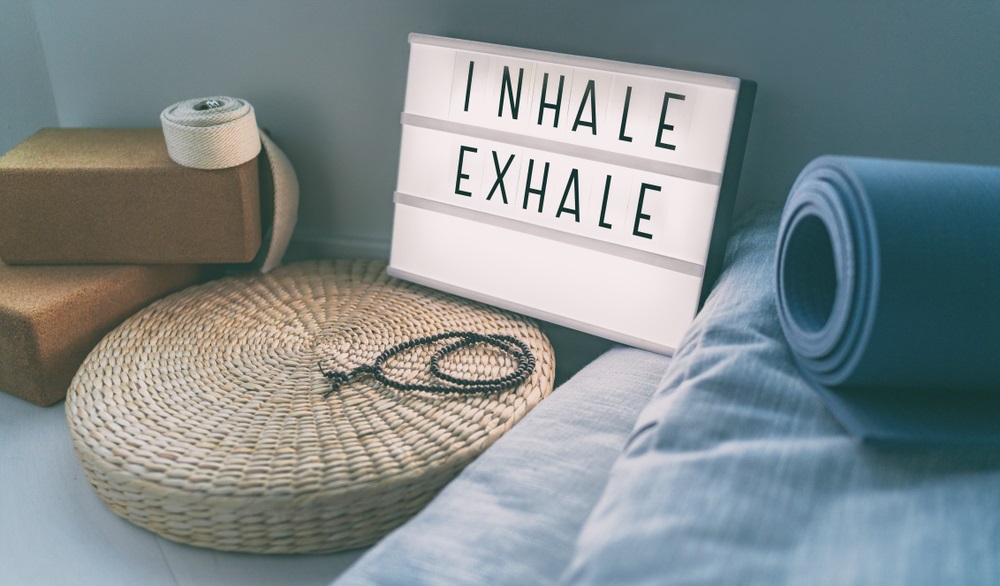Zen breathing, also known as zazen breathing, refers to breathing techniques used in Buddhist meditation practices. The underlying concept for each breathing technique is to observe the natural rhythm of the breath. Some techniques may also include deep breathing to promote focus and relaxation.
Ultimately, Zen breathing improves focus, reduces stress and anxiety, and promotes a sense of calm, relaxation, and well-being. This article will explore 5 Zen breathing techniques for better sleep and will provide the steps to practice them.
1. Ganana
Ganana is a breath-counting technique commonly used in Buddhist meditation. It is one of the six stages of Anapanasati, a Zen meditation technique practiced by Buddhist monks. It aims at developing awareness and equanimity by observing the breath without trying to change it. The meditation is done in six stages, and ganana is the first stage.
You can practice ganana before falling asleep to calm your mind and promote deep relaxation. It involves drawing your attention to each inhalation and exhalation by counting them.
How to Do It
- Sit upright or lie down on your bed.
- Close your eyes and bring your attention to your breath.
- Take a deep breath through your nose, allowing your lungs to fill up completely with air.
- Hold your breath for 5 seconds.
- Slowly exhale through your mouth, emptying all the air out of your lungs.
- Repeat steps 3, 4, and 5 three times to help your mind and body relax.
- Resume normal breathing for 30 seconds, breathing in and out through your nose.
- Nowbegin ganana breath-counting.
- Count 1 as you inhale and 2 as you exhale.
- Count 3 as you inhale and 4 as you exhale.
- Continue to count each inhale and exhale up to 10.
- When you reach 10, start over again at 1.
- Continue the ganana breath counting for 5-10 minutes or until you feel calm and relaxed.
2. Breath-Cycle Observation
Observing your breath cycle is another useful technique for reducing stress and enabling relaxation. To do this, you simply pay attention to the breath cycle as the air flows in and out.
How to Do It
- Sit upright or lie down on your bed.
- Take a deep breath in through your nose, open your mouth, and exhale all the air out to help your body and mind relax. You can repeat this two more times if you’d like.
- Resume your normal breathing rhythm, inhaling and exhaling through the nose.
- Notice the air as it enters through your nose and flows into your chest down toward your belly. Observe the chest and abdomen rise with your inhalation.
- As you exhale, observe as your abdomen contracts, your chest falls, and the air leaves your body through the nostrils.
- Remain aware of each breath cycle. Do you notice the air moving in and out through your nose? Does the air feel warm or cold in your nostrils? Can you hear the gentle sound of your breath?
- Keep observing the breath for 5-10 minutes or until you feel calm and relaxed.
3. Diaphragmatic Breathing
Diaphragmatic breathing is also known as belly breathing. It involves breathing deeply in order to completely fill the lungs, circulating more oxygen to the body and brain. It can be a useful technique for better sleep, as it promotes relaxation.
Studies show that diaphragmatic breathing also lowers your heart rate and blood pressure, while strengthening the diaphragm and thoracic muscles.

How to Do It
- Sit upright or lie down on your bed.
- Place your hands on your belly.
- Now, imagine your belly is a balloon.
- Breathe in slowly through your nose, drawing breath down into your abdomen. Notice your belly expanding like a balloon filling with air.
- Hold the breath in for a count of two and expand the belly further.
- Exhale slowly through your mouth, letting all the air out and notice your belly contracting inward, like the balloon is deflating.
- Repeat this breathing technique for 5-10 minutes or until you feel relaxed and calm.
4. Square Breathing
Square breathing, also known as box breathing, is an effective breathing technique for becoming calm and grounded. It can also help you wind down and relax for better sleep.
This technique involves a cycle of breathing in, holding your breath in, breathing out, and then holding your breath out for equal periods of time. When you feel comfortable with this, you can try increasing the length of each breath segment.
How to Do It
- Sit upright or lie down on your bed.
- Take a few deep breaths to help you settle in.
- Now begin square breathing.
- Inhale through your nose for a count of 4.
- Hold your breath in for a count of 4. Try not to tense your muscles as you hold the breath. Just lightly retain the air, keeping your muscles relaxed.
- Exhale for a count of 4.
- Hold your breath out for a count of 4, relaxing your body.
- Repeat the square breathing cycle for 5-10 minutes or until you feel calm and relaxed. You may increase the count to 5 seconds or 6 seconds for each segment if that feels comfortable.
5. Alternate Nostril Breathing
Alternate nostril breathing is a popular breathing technique used in yoga and Zen meditation to cultivate awareness and become calm and grounded. It also promotes relaxation to fall asleep easily.
How to Do It
- Sit upright, perhaps in a chair or on the edge of your bed.
- Rest your left hand on your thigh or belly.
- Raise the right hand towards your face with the index finger and thumb extended.
- Plug your right nostril with your right thumb and breathe in through the left nostril.
- At the top of the inhalation, release your right thumb, plug the left nostril with your index finger, and then breathe out through the right nostril.
- Keep the fingers where they are and breathe in through your right nostril.
- Once again, switch nostrils at the top of the breath. Plug the right nostril with your thumb, release the index finger, and breathe out through the left nostril.
- Inhale on the left side. Switch nostrils to exhale.
- Inhale on the right side. Switch nostrils to exhale.
- Repeat this breathing cycle for 5-10 minutes or until you feel relaxed and calm.
Conclusion
There are various Zen breathing techniques for better sleep. You may practice them on their own as part of your bedtime routine or you can practice them along with other relaxation techniques for better sleep.
For example, you can practice one or more Zen breathing techniques while listening to nature sounds, as a part of a mindfulness meditation, or after diffusing your bedroom with calming essential oils.
Try all the breathing techniques above in order to discover the best ones for you.

